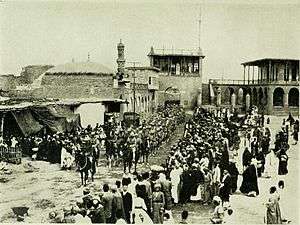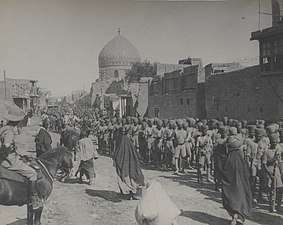Fall of Baghdad (1917)
The Fall of Baghdad (11 March 1917) occurred during the Mesopotamia Campaign, fought between the forces of the British Indian Army and the Ottoman Turkish Empire in the First World War.
| Fall of Baghdad | |||||||
|---|---|---|---|---|---|---|---|
| Part of the Mesopotamian Campaign of World War I | |||||||
 General Maude's entry into Baghdad, 11 March 1917 | |||||||
| |||||||
| Belligerents | |||||||
|
| |||||||
| Commanders and leaders | |||||||
|
|
| ||||||
| Strength | |||||||
|
I Corps III Corps (50,000 men) | Sixth Army (25,000 men) | ||||||
| Casualties and losses | |||||||
| Unknown | Over 9,000 taken prisoner | ||||||
Arrival of General Sir Frederick Stanley Maude
After the surrender of the Kut garrison on 29 April 1916, the British Army in Mesopotamia underwent a major overhaul. A new commander, Lieutenant General Sir Frederick Stanley Maude, was given the job of restoring Britain's military reputation.
General Maude spent the rest of 1916 rebuilding his army. Most of his troops were recruited in India and then sent by sea to Basra. While these troops were being trained, British military engineers built a field railway from the coast up to Basra and beyond. General Maude also obtained a small force of armed river boats and river supply ships.
The British launched their new campaign on 13 December 1916. The British had some 50,000 well-trained and well-equipped troops: mostly British India troops of the Indian Expeditionary Force D together with the 13th (Western) Division of the British Army forming the Mesopotamia Expeditionary Force. The Indian divisions of the Indian III Corps (also called the Tigris Corps) included British Army units. The Ottoman forces were smaller, perhaps around 25,000 strong under the overall command of General Khalil Pasha.
March on Baghdad

There were no setbacks for the British on this campaign. General Maude proceeded cautiously, advancing on both sides of the Tigris River. He earned his nickname Systematic Joe. The Ottoman forces contested a fortified place called the Khadairi Bend which the British captured after two weeks of siege work (6 January to 19 January 1917). The British then had to force the Ottoman forces out of a strong defensive line along the Hai River. This took them two more weeks (from 25 January till 4 February). Another Ottoman position, called Dahra Bend, was taken on 16 February. Finally, the British re-captured Kut on 24 February 1917 in the Second Battle of Kut.
The local Ottoman commander, Karabekir Bey, did not let his army become trapped in Kut, as General Townshend had been in the First Battle of Kut.
The march on Baghdad resumed on 5 March 1917. Three days later, Maude's corps reached the Diyala River on the outskirts of the city.
Khalil Pasha chose to defend Baghdad at the confluence of the Diyala and the Tigris, some 35 miles south of Baghdad. The Ottoman troops resisted the initial British assault on 9 March. General Maude then shifted the majority of his army north. He believed that he could outflank the Ottoman positions and strike directly for Baghdad. Khalil Pasha responded by shifting his army out of its defensive positions to mirror the move of the British on the other side of the river. A single regiment was left to hold the original Diyala River defences. The British crushed this regiment with a sudden assault on 10 March 1917. This sudden defeat unnerved Khalil Pasha and he ordered his army to retreat north to Baghdad.
The Ottoman authorities ordered the evacuation of Baghdad at 8 p.m. on 10 March, but the situation was rapidly moving beyond Khalil Pasha's control. The British followed close on the heels of the Ottoman troops and captured Baghdad without a fight on 11 March. A week later, General Maude issued the Proclamation of Baghdad, which included the line, "Our armies do not come into your cities and lands as conquerors or enemies, but as liberators".[1] Some 9,000 Ottoman troops were caught in the confusion and became prisoners of the British.
The British were worried that the Ottoman government might try to flood the Tigris plain. As it happened, this fear was unfounded. The Ottoman troops never attempted to flood the area.
Consequences
The result was a decisive victory for the British and yet another defeat for the Ottoman government. The humiliation for the British due to the loss of Kut had been partially rectified. The Ottoman government was forced to end its military operations in Persia and try to build up a new army to prevent the British from moving on to capture Mosul.
The capture of Baghdad, a provincial capital, also meant that the first Ottoman province had fallen under British control. Although good news for the British forces, this caused a great deal of bureaucratic fighting between the British government in London and the British government in India.
Once he captured Baghdad, Maude was the de facto Governor of Mesopotamia from Basra to Baghdad. Sir Percy Cox, the Tigris Corps Political Officer, attempted to issue a proclamation stating that the province was under joint British-Indian administration, but London ordered Cox not to issue his proclamation and came out with its own proclamation asking Arab leaders to aid the British administration instead.
At the same time, the Indian colonial government had different ideas. After all, they had been the prime movers behind Mesopotamia in the first place. The British government in India wanted this new area placed under its direct control.
This power struggle led to the creation of the Mesopotamian Administration Committee, under the leadership of Lord Curzon. Its main task was to determine who would govern the Basra and Baghdad provinces. Its ruling was a British, not Anglo-Indian, administration for Basra and an Arab authority for Baghdad.
Notes
- The proclamation of Baghdad, Sir Stanley Maude, Harper's Magazine
References
- Bruce, A. (n.d.). 17 February – 11 March 1917 – The Capture of Baghdad. [Electronic Version]. An Illustrated Companion to the First World War.
- Duffy, M. (2002). Battles: The Capture of Baghdad, 1917. The First World War. Retrieved 17 August 2005.
- Fromkin, David (2001). A Peace to End All Peace: The Fall of the Ottoman Empire and the Creation of the Modern Middle East. New York: Henry Holt and Company. ISBN 0-8050-6884-8.
- Official Dispatch about the Operations Leading to the Fall of Baghdad, General Maude.
- Report about the capture of Baghdad, Manchester Guardian.
Further reading
- Barker, A. J. The Bastard War: The Mesopotamian Campaign of 1914–1918. New York: Dial Press, 1967. OCLC 2118235